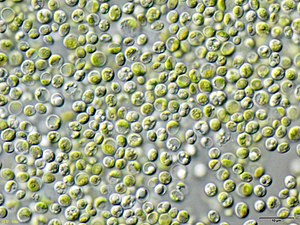Chlorella vulgaris
| Chlorella vulgaris | ||||||||||||
|---|---|---|---|---|---|---|---|---|---|---|---|---|

Chlorella vulgaris |
||||||||||||
| Systematics | ||||||||||||
|
||||||||||||
| Scientific name | ||||||||||||
| Chlorella vulgaris | ||||||||||||
| Beij. |
Chlorella vulgaris is a unicellular green alga . The cells have a diameter of approx. 4–10 μm and a spherical shape. The vegetative reproduction takes place through the formation of auto spores. Sexual reproduction is not known. Chlorella vulgaris occurs in standing and running waters, in both fresh and brackish water, but is also found on solid surfaces. It is spread all over the world.
This species was isolated by Martinus Willem Beijerinck near Delft in 1889 . As a type of the genus Chlorella, it is stored in official master collections such as the German Collection of Microorganisms and is further bred there.
In addition to Chlorella lobophora and Chlorella sorokiniana , it belongs to the genus Chlorella within the class of Trebouxiophyceae. Chlorella vulgaris used to be known as Chlorella pyrenoidosa , along with other similar-looking species . In 1992, however, it was shown that there is no such thing as a type of “Chlorella pyrenoidosa” .
Chlorella vulgaris has been used as a model organism in scientific research for a long time. The mechanism of photosynthesis was deciphered with this alga.
Chlorella vulgaris is also of increasing economic importance. This microalgae can be cultivated in large quantities and is used as a food supplement, as a raw material for the cosmetics industry and as larval feed in aquaculture . In Germany ( blocks in the Altmark) is the largest microalgae farm in Europe exists, specializing in the cultivation of Chlorella vulgaris .
In the 1950s, the cultivation of microalgae such as Chlorella vulgaris began. At that time, the focus was on the question of how the growing world population can be supplied with sufficient protein in the future. The dried biomass of Chlorella vulgaris contains approx. 50 percent protein and the yield per hectare is up to 120 t / a, far above that of conventional agriculture (e.g. wheat: approx. 7 t / a / ha).
In the meantime this alga is also interesting as a source of certain polyunsaturated fatty acids (e.g. alpha-linolenic acid ) and carotenoids (e.g. lutein ).
literature
- Jörg Ullmann: The difference between Chlorella vulgaris and Chlorella pyrenoidosa . On the position of the taxa "Chlorella pyrenoidosa" CHICK and Chlorella vulgaris BEIJERINCK within the Chlorophyta (green algae). 2006
Web links
Individual evidence
- ↑ L. Krienitz, EH Hegewald, D. Hepperle, VAR Huss, T. Rohr, M. Wolf: Phylogenetic relationship of Chlorella and Parachlorella gen. Nov. (Chlorophyta, Trebouxiophyceae). In: Phycologia , 43, 2004, pp. 529-542, doi: 10.2216 / i0031-8884-43-5-529.1 .
- ↑ E. Kessler, VAR Huss Comparative physiology and Biochemistry and taxonomic assignment of the Chlorella (Chlorophyceae) strains of the culture collection of the University of Texas at Austin. In: Journal of Phycology , 28, 1992, pp. 550-553, doi: 10.1111 / j.0022-3646.1992.00550.x .